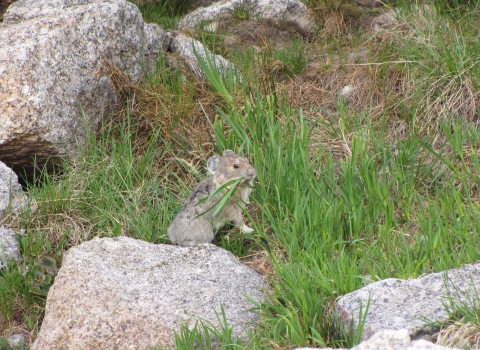President Biden’s Bipartisan Infrastructure Law is a major investment in the conservation and stewardship of America’s public lands that will lead to better outdoor spaces and habitats for people and wildlife for generations to come. The law’s $1.4 billion for Ecosystem Restoration and Resilience is a significant down payment in protecting our shared natural heritage. With these resources, the Department of the Interior is collaborating with states, Tribes and local communities to invest millions of dollars annually to restore habitat connectivity for aquatic species around the country and advance habitat restoration, invasive species invasive species
An invasive species is any plant or animal that has spread or been introduced into a new area where they are, or could, cause harm to the environment, economy, or human, animal, or plant health. Their unwelcome presence can destroy ecosystems and cost millions of dollars.
Learn more about invasive species control, conservation of at-risk and listed species and benefits to several significant ecosystems.
Bipartisan Infrastructure Law Ecosystem Restoration Projects Led by the U.S. Fish and Wildlife Service
Hawaiian Forest Bird Extinction Prevention -- $6,500,000 -- This project supports Hawaiian forest bird extinction prevention through construction of additional forest bird captive propagation facilities. Additionally, the project supports landscape-level implementation of a biological control to reduce the mosquito vector that causes avian malaria, a significant factor that causes forest bird decline. In a related project, an additional $1,000,000 will support landscape-scale eradication techniques for invasive mosquitoes on several Hawaiian islands, including Hawaii, Oahu, Maui, and Kauai.
Invasive Species Prevention -- $1,852,550 – The project supports grants to prevent the introduction and spread of invasive species through strategic landscape-level approaches.
Visitation Trends on National Wildlife Refuges -- $300,000 – This project will measure and analyze visitation trends on national wildlife refuges using systematic social science monitoring of the characteristics, experiences, and spending of visitors to highly visited national wildlife refuges.
Improving Virtual Recreational Trip Planning on National Wildlife Refuges -- $100,000 – This project will help improve virtual trip planning experiences for recreational visitors to national wildlife refuges and wetland management districts by developing more user-friendly trip planning tools on fws.gov and will work to configure an OMB-approved government survey instrument called Touchpoints to measure customer satisfaction and usefulness of trip planning tools.
Improve Wayfinding Signs on National Wildlife Refuges -- $600,000 – This project will assist in maintaining visitor satisfaction while ensuring adequate resource protection by improving signage at national wildlife refuges experiencing elevated visitation levels.
Native Seed Collection and Production -- $2,000,000 -- This project will enhance eco-regional collaboration to increase native seed collection and production for use in ecological restoration in key geographies. Native seed collection will follow the established, science-based “Seeds of Success” protocols for training, seed collection, handling, and storage. Increasing the supply of native seeds and plants for restoration will create private sector jobs and expand agency botanical capacity to support national coordination on implementing the National Seed Strategy. Additionally, there will be coordination to support restoration of native plant communities on national wildlife refuges with $1,840,000 dedicated to addressing environmental hazards at abandoned mined lands.
Mitigating Physical and Environmental Hazards on Mined USFWS Lands -- $1,000,000 -- The Service will mitigate physical safety and environmental hazards on mined Service lands. Actions will include assessment of physical safety hazards, mitigation of safety hazards, and assessment of environmental contamination. Risks to employee, visitor, and wildlife health and safety will be mitigated with these projects.
- Biden-Harris Administration Announces More than $68 Million from Bipartisan Infrastructure Law to Conserve and Strengthen Ecosystems and Economies
- Planned ecosystem projects from bureaus in the Department of the Interior.



